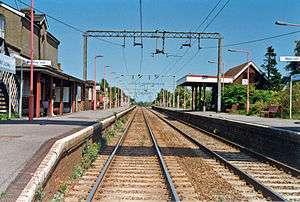Great Bentley railway station
Great Bentley railway station is on the Sunshine Coast Line, a branch of the Great Eastern Main Line, in the East of England, serving the village of Great Bentley as well as the nearby settlements of Brightlingsea, Frating, Thorrington and St Osyth. It is 60 miles 66 chains (97.9 km) down the line from London Liverpool Street[1] and is situated between Alresford to the west and Weeley to the east. Its three-letter station code is GRB.
| Great Bentley | |
|---|---|
 Great Bentley railway station | |
| Location | |
| Place | Great Bentley |
| Local authority | Tendring |
| Coordinates | 51.852°N 1.065°E |
| Grid reference | TM112214 |
| Operations | |
| Station code | GRB |
| Managed by | Abellio Greater Anglia |
| Number of platforms | 2 |
| DfT category | E |
| Live arrivals/departures, station information and onward connections from National Rail Enquiries | |
| Annual rail passenger usage* | |
| 2014/15 | |
| 2015/16 | |
| 2016/17 | |
| 2017/18 | |
| 2018/19 | |
| History | |
| 8 January 1866 | Opened as Bentley Green |
| 1877 | Renamed Great Bentley |
| National Rail – UK railway stations | |
| * Annual estimated passenger usage based on sales of tickets in stated financial year(s) which end or originate at Great Bentley from Office of Rail and Road statistics. Methodology may vary year on year. | |
The station was opened by the Tendring Hundred Railway, a subsidiary of the Great Eastern Railway, in 1866 with the name Bentley Green. It was renamed Great Bentley in 1877. It is currently managed by Greater Anglia, which also operates all trains serving the station.
History

In 1859 the Tendring Hundred Railway was formed to extend the branch line from Hythe to Wivenhoe, which opened on 8 May 1863 for both passenger and goods services from Colchester. By the time the Wivenhoe extension opened, the line was operated by the Great Eastern Railway (GER) which bought the line from the Tendring Hunded Railway in 1883.
The line was then extended to Weeley on 8 January 1866. Bentley Green station opened on the same day. It adopted its current name of Great Bentley in 1877.
Initially the station was served by a single track but the line was doubled between Great Bentley and Thorpe-le-Soken by the GER in 1891. The Wivenhoe to Great Bentley section was doubled in 1898.[2]
Operation of the station passed to the London and North Eastern Railway in 1923. In 1948 the station became part of the Eastern Region of British Railways. The 1955 modernisation plan proposed the electrification of the line through Great Bentley and electric services commenced on 13 April 1959.
There was once a small goods yard to the east of the station which had cattle pens, coal wharves and an end loading ramp. In later years the main traffic was coal, agricultural fertilisers and sugar beet.[3] The yard was closed in the 1950s.
Network Rail replaced the manually-controlled level crossing gates at Great Bentley with barriers in 2008 as part of a £104 million resignalling project between Colchester and Clacton-on-Sea. The former signal box was located at the eastern end of the "up" (London-bound) platform and had 25 levers for the signals and points.[4]
Great Bentley has two platforms. Platform 1 is used for westbound services towards Colchester and London Liverpool Street. Platform 2 is for eastbound services towards Clacton-on-Sea and Walton-on-the-Naze. When built, the two platforms were linked with a lattice footbridge. This was removed in the 1950s when the line was being prepared for electrification.
Services
Current timetable
The typical service pattern is:
| Operator | Route | Rolling stock | Frequency | Notes |
|---|---|---|---|---|
| Greater Anglia (train operating company) | Colchester - Colchester Town - Hythe - Wivenhoe - Alresford - Great Bentley - Weeley - Thorpe-le-Soken - Kirby Cross - Frinton-on-Sea - Walton-on-the-Naze | Class 321 | 1x per hour | Monday-Saturday |
| Greater Anglia (train operating company) | London Liverpool Street - Stratford - Shenfield - Chelmsford - Witham - Colchester - Wivenhoe - Alresford - Great Bentley - Thorpe-le-Soken - Clacton-on-Sea | Class 321, Class 360 | 1x per hour | Sundays only |
Historical timetables
The following services called in July 1922 (the last year of operation by the Great Eastern Railway):
- 8 up services (Monday-Saturday)
- 9 down services (Monday-Saturday)
- 4 up services (Sundays)
- 3 down services (Sundays)[5]
In June 1956 the timetable showed:
- 17 up services to Colchester (Monday-Saturday)
- 15 down services to Clacton (Monday-Saturday)[6]
During the summer of 1972 the timetable showed:
- 17 up services to Colchester (Monday-Friday)
- 18 down services to Clacton (Monday-Friday)
Some services worked through to Liverpool Street. On summer Saturdays, 24 down and 21 up trains called.[7]
References
- http://www.s-r-s.org.uk/railref/ref-ge.html
- Great Eastern Railway Society Journal 111 page 24 S Jenkins
- Great Eastern Railway Society Journal 111 page 27 S Jenkins
- Great Eastern Railway Society Journal 111 page 28 S Jenkins
- Bradshaws July 1922 Railway Guide (reprint) DAVID AND CHARLES 1985
- Great Eastern Railway Society Journal 111 page 27 S Jenkins July 2002 ISSN 0143-0866
- Great Eastern Railway Society Journal 111 page 27 S Jenkins
External links
- Train times and station information for Great Bentley railway station from National Rail
| Wikimedia Commons has media related to Great Bentley railway station. |
- Great Bentley village website with a picture of two steam locomotives at this station
- Great Bentley station interactive plan
- Live departures from Great Bentley
| Preceding station | Following station | |||
|---|---|---|---|---|
Alresford | Abellio Greater Anglia | |||
| Historical railways | ||||
Line open, station closed | Great Eastern Railway Tendring Hundred Extension Railway | Line and station open |
||